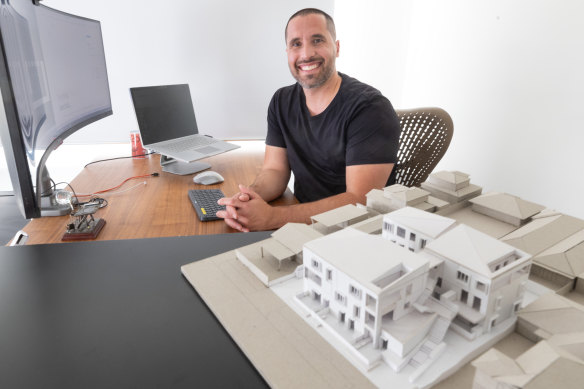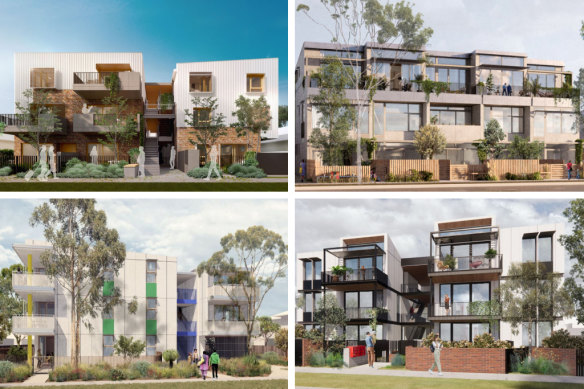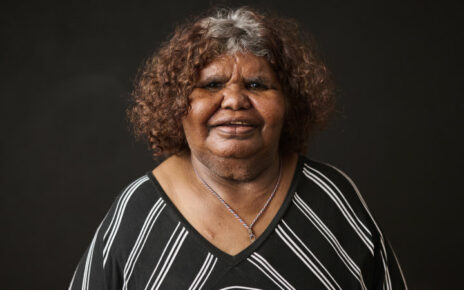Save articles for later
Add articles to your saved list and come back to them any time.
Key points
- The government first launched Future Homes in March 2021 with four endorsed designs selected to be fast tracked through the planning process.
- Only one council, Maribyrnong, signed up to a pilot of the scheme and in over two years not a single Future Homes building has been approved.
- The government wants to change the lack of progress on the Future Homes program by rolling it out across Victoria.
A Facebook post by Daniel Andrews – just before he resigned as premier – offers a glimpse at the type of homes the government wants Victorians of the future to live in.
The post of three home designs was to promote the government’s Future Homes program, part of its housing package released last week, and features off-the-shelf designs created for the state government in 1927, 1962 and 2023.
The floor plans and design for the 1927 option is a two-bedroom home featuring a Federation-style bungalow with a peaked roof, front and back verandahs and separate living room and kitchen. The 1962 design is for a low slung brick bungalow in the Californian style, with three bedrooms and a combined living area.
But the 2023 Future Homes designs are a major departure from a single home on a suburban block. They are three-storey apartments blocks with between 12 and 17 homes.
The government sees these medium-density developments for the “missing middle” as key to addressing the housing crisis. Infrastructure Victoria warns that 44,000 new homes are needed annually.
Andres Lopez, founder of Agency for Design Strategy, is one of the architects whose designs were selected as part of the Future Homes program. He said his design takes a traditional block of apartments and “explodes it”.
Andres Lopez is one of the architects who has designed apartment blocks for the government’s Future Homes scheme. Credit: Jason South
“We’ve pushed the apartments to the corners and created a central communal space,” he said. Lopez said his design created a sense of community and belonging, as well as natural light and ventilation.
The government wants to see these Future Homes built across Victoria. Central to last week’s housing package was its pledge to “expand the Future Homes program to encourage more builds”.
The scheme launched in March 2021 with four endorsed designs selected to be fast tracked through the planning process. However, only one council, Maribyrnong, signed up to a pilot – and in more than two years, not a single Future Homes building has been approved.
Other councils were flagged to participate in the trial but did not sign up, with Darebin council “unable to meet the state government’s compressed timeframe” and Monash “seeking more details and a robust strategic process to identify the location of the homes”.
The government wants to change the lack of progress on the Future Homes program by rolling it out across Melbourne. Its housing package says the homes can be “purchased by developers and adapted to a site through a streamlined planning process”.
It is also increasing the height limit up to five storeys for the Future Homes apartment blocks, commissioning more designs and “expand[ing] the areas where they can be used”.
The program will be expanded statewide to cover general residential zones within 800 metres of a passenger train station or a so-called activity centre, a place where people gather such as a shopping strip or university.
A spokesperson for the government declined to provide details about the logistics of expanding the program or how many homes it aimed to build.
The four off the shelf Future Homes designs.
“Victorians deserve high-quality residential apartment buildings in accessible locations across the state – that’s why we’re expanding the Future Homes program to encourage more new builds through a streamlined planning process,” they said.
Jane Keddie, director at Hansen Partnership and vice president of the Planning Institute of Australia’s Victorian division, said the Future Homes program potentially offered significant time and cost savings.
“Provided you use these designs, it removes third-party appeal rights,” she said. “Neighbours would be notified and could provide comments and suggestions, but there would be no VCAT [Victorian Civil and Administrative tribunal] process.”
However, critics of the program say its impact will be minimal as the Future Homes cannot be built in areas subject to heritage restrictions. The designs also generally require two 600 square metre blocks next to each other, which are in low supply in developed areas.
Planner Colleen Peterson, of Ratio Consultants, said Future Homes was “no silver bullet” for housing affordability.
“The program talks about shortcutting and facilitating the planning process but does not talk about how that will occur,” she said. “This is a good program but can’t be relied upon to solve the housing crisis.”
Get the day’s breaking news, entertainment ideas and a long read to enjoy. Sign up to receive our Evening Edition newsletter.
Most Viewed in Politics
From our partners
Source: Read Full Article




